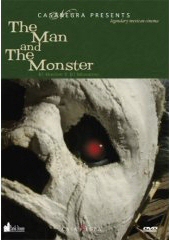
Even a cursory examination of Mexican horror cinema suggests the debt that this lively and vibrant genre owes to its cultural folklore and supernatural archetypes. Mexi-Horror bursts with mythic and literary monsters. The timeless figure of the undead prowls the ghastly after-life in The Vampire, linen-wrapped corpses stalked the hacienda in the Aztec Mummy series, and La Llorna cursed the night with her lamentations in Curse of the Crying Woman (one of many films to exploit this fan favorite). Using as its source material/inspiration not precisely a motif from folklore but a respected and compelling character from literature, The Man and the Monster tackles Robert Stevenson's Dr. Jekyll and Mr. Hyde. Combining Gothic sensibility and the outrageous fun of Mexican adventure in a story whose plot and themes are rooted in the heart of universal tragedy, this re-interpretation of a classic text is one of the unsung legends of Mexican horror, combining earnest and seriously approached tragic material with the feisty pleasures of the matinee monster show. Continuing to rescue both obscure and fondly remembered Mexi-horror films in technologically superb editions, CasaNegra releases this timeless take on the dual-personality/Faustus myth completely restored.
In a story whose principle plot-line and protagonist is equal parts Faustus, Hyde, and Byronic anti-hero, Sameul (played by the unerring Enrique Rambal) is a pianist whose ambition surmounts his good sense (and morality), causing him to sell his immortal soul to Satan in exchange for musical genius. A staple of Western and European folklore, this compact with the devil motif fit's the genre and this director's particular storytelling sense wonderfully. "El Hombre Y El Monstruo" is carefully paced, dramatic, and as intense in it's depiction of flawed human characters as it is provocative in its suspense and old fashioned yet not outdated scares. The major themes here are timeless as sin and greed, and occupy a moralistic space somewhere between sin and redemption. The price that Sameul pays for his dark gift is horrible indeed, transforming into a monster each time he plays the composition that wins him fame and wealth. In a move of classic irony, the very gift that brings him his heart's desire brings him terror, and the principle tension of the script focuses on this inner conflict. To avoid transforming into a blood-stained killer, Samuel can never again play his most famous piece of music . . . But is he willing to ignore his gift?
A nearly perfect monster movie of the old school, compelling in its humane approach to its titular monster, The Man and the Monster is emotionally intense. Far more than physical violence, drooling monsters, and pulp-style thrills are emphasized. Souls and sanity wait in the balance as man struggles with his conscience (or lack thereof). Not a typical creature feature, the major themes of sacrifice, price, and personal Id/Ego vs. the welfare of society are played out in operatic fashion. A neglected dark masterpiece of tension and visual aplomb, 'Monster kids' will get a kick out of the shlocky makeup of Sameul, who resembles a shaggy cross between a dog and a werewolf. The enticing grotesqueness of the story is mirrored by dazzling shot nightmare set-pieces. Baledon creates a morally challenging fable, one which is pleasing as both a horror film and moral allegory. If the make-up effects are somewhat lacklustre, the quality of the performances and the essential fire of human frailty that informs the plot more than make up for it. A must see addition to the genre, this is cinema as both entertainment and investigative tool, and belongs on the shelf next to some of the Italian gothics that it resembles in mood.
Casa Negra continues with this release their tradition of cleaning up films that simply have no right to look this good! The Man and the Monster is presented in 1:33 Full Frame. The transfer is sharp and clean. The black & white photography sports deep shadows and wonderful levels of depth and detail. Audio is featured in an original Spanish language tracks (with optional English subs) and an English-dubbed track. The later may well be recalled by older folks as the one they caught on television, dubbed and produced by K. Gordon Murray. Of course the original Spanish language version is more authentic and truer to the spirit of the story. It is also clearer, as the English version is marred somewhat by scratches. Despite this, both tracks are certainly listenable.
Extras are delightful if not as informative or generous as those that accompanied such releases as Curse of the Crying Woman or The Witch's Mirror. No commentary is offered, replaced by a the "Mexican Poster Sideshow," which is a generous selection of lively and unique poster art from some of the best (and not so great!) Mexican horror films from 1950 to 1975. Included are the Nostradamus series, Ladron De Cadaveres, Fangs of the Screaming Werewolf, La Loba, Santo vs. the Vampire, etc. Next up is a fun "Radio Spot" for the theatrical run, on a double bill The Bloody Vampire (from the late 60s). "Cast Bios" include examinations of Abel Salazar, Martha Roth, Ofelia Guilmain, and Enrique Rambal. Lastly we have a nicely representative "Poster and Still Gallery," featuring rather nicely preserved publicity shots and poster art.
Review by William P. Simmons
| Released by Casa Negra |
| Region 1 - NTSC |
| Not Rated |
| Extras : |
| see main review |